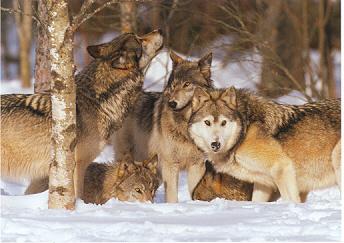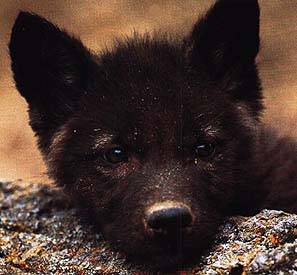
Structure of the wolf pack

The wolf is the largest wild member of the dog family Canidae. A wolf population can cover thousands of square kilometers in discrete but interacting breeding units (Mladenoff, 1995). There are 5 subspecies of the gray wolf in North American, all of which overlap within a given geographical area (Schullery, 1996): arctic wolf, eastern timberwolf, great plains wolf, rocky mountain wolf, and mexican wolf. The red wolf (Canis rufus) is found in the southeastern United States, and the abyssinian wolf (Canis simensis) is found in the highlands of Ethiopia (www.wolf.org).
Wolves are social animals and they live in extended family and breeding units called wolf packs. A single pack consists of on average 10 wolves, but may range from 2 to 30 wolves, all which have strong bonds to each other (Schullery, 1996). Wolf pack territory boundaries are stable over long periods of time, and are in part a result of constant territorial pressure of other packs (Mech, 1977). Wolves are intolerant and hostile to others not in their own pack, and packs avoid contact even though specific ranges overlap (Tanner, 1975). Distinct packs occupy great ranges of land. A pack on Isle Royale was observed to be traveling 9 miles per day (Zimen, 1981). They are a nomadic species that spend their days roaming, hunting, eating, playing, and sleeping.
 A
pack is initially formed when a male and female wolf bond as a pair, breed,
and have a litter of pups. Thus nearly all the pack members are related to the
breeding pair, and within each pack there exists a clear ranking order. Central
to the internal social structure of the pack are the alpha male and alpha
female. These are the dominant wolves in the pack, and it is presumed that
they lead the hunting and the movement of the pack (Steinhart, 1995). Female
wolf dominance is indicated by relative position in greeting ceremonies and
instigation of aggressive interactions, such as chases, threats, and biting
(Sillero-Zubiri, 1994). Determined and aggressive subordinate wolves may challenge
this dominant position. Alpha wolves can be identified by how they carry themselves,
and they tend to have a raised tail. "It may be that among wolves the
alpha is the dominant not by virtue of an aggressive nature or a sharper bite,
but by virtue of an ability to hold the pack together, to give it comfort and
coordination and belonging (Steinhart, 1995)." The alpha pair are not
necessarily the biggest or the meanest wolves, but perhaps they are the wisest
and most able to lead and take care of each member within its pack.
A
pack is initially formed when a male and female wolf bond as a pair, breed,
and have a litter of pups. Thus nearly all the pack members are related to the
breeding pair, and within each pack there exists a clear ranking order. Central
to the internal social structure of the pack are the alpha male and alpha
female. These are the dominant wolves in the pack, and it is presumed that
they lead the hunting and the movement of the pack (Steinhart, 1995). Female
wolf dominance is indicated by relative position in greeting ceremonies and
instigation of aggressive interactions, such as chases, threats, and biting
(Sillero-Zubiri, 1994). Determined and aggressive subordinate wolves may challenge
this dominant position. Alpha wolves can be identified by how they carry themselves,
and they tend to have a raised tail. "It may be that among wolves the
alpha is the dominant not by virtue of an aggressive nature or a sharper bite,
but by virtue of an ability to hold the pack together, to give it comfort and
coordination and belonging (Steinhart, 1995)." The alpha pair are not
necessarily the biggest or the meanest wolves, but perhaps they are the wisest
and most able to lead and take care of each member within its pack.
Hierarchical structure is characteristic of wolf packs,
and this brings up issues of aggression between pack members. Zimen (1981)
claims that wolves do not live in groups in which there is no aggression, so
therefore aggression and hierarchical structure must be advantageous, if not
to the group, then to individual wolves. Wolf studies provided evidence that
aggression is correlated with seasonal behavior changes (Zimen, 1981).  During
the summer the pack is preoccupied with raising the pups, and is generally less
active and the endogenous factor in aggressiveness is small. The summer time
establishes firm rank positions in the pack, however towards the fall aggressiveness
increases. Pups begin competing for rank, juveniles look to make upward shifts,
and older wolves make repressive moves for the first time. Clashes in ranking
order provide the opportunity for a new order to be established, and this coincides
with the onset of the mating season, after which aggression subsides (Zimen,
1981).
During
the summer the pack is preoccupied with raising the pups, and is generally less
active and the endogenous factor in aggressiveness is small. The summer time
establishes firm rank positions in the pack, however towards the fall aggressiveness
increases. Pups begin competing for rank, juveniles look to make upward shifts,
and older wolves make repressive moves for the first time. Clashes in ranking
order provide the opportunity for a new order to be established, and this coincides
with the onset of the mating season, after which aggression subsides (Zimen,
1981).
Evidence also states that wolf social behavior is influenced by the state of food supply, and hunger leads to an increase in aggressive behavior and a weakening of social bonds (Zimen, 1981). Aggression may be helpful in the group because it provides competition and will lead to a stronger, more unified group of animals. The reason aggressive behavior is not destructive to the group is in part because of the hierarchical social structure and the solid role of the alpha pair. The pack size remains relatively consistent as well, and this might also be a result of competition among pack members. Wolves exhibit dispersal tendencies, and subordinate wolves may even be driven out of their pack and forced to travel alone in search of a new pack. To balance dispersers, wolves may immigrate from neighboring packs. The wolves seem to regulate the size of the pack themselves.
next to Wolf movements and territories
return to Social Structure & Dispersal
return home